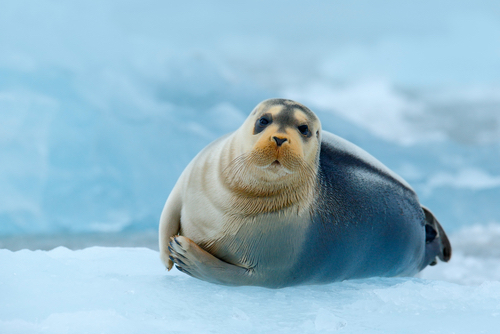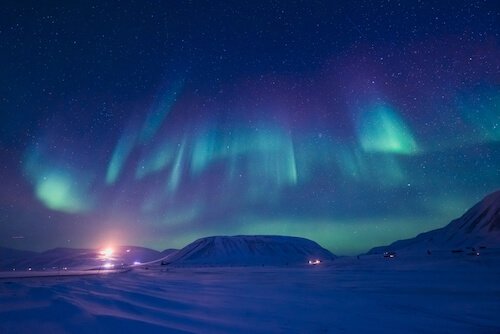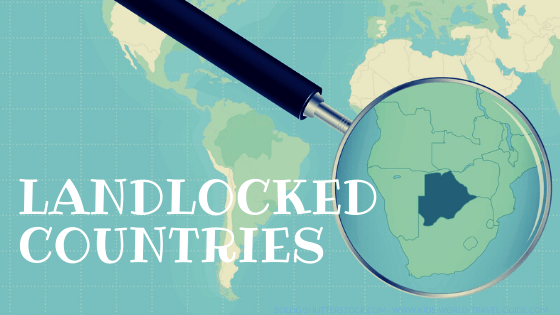Arctic Ocean Facts for Kids
Here are our Top Ten Arctic Ocean Facts for Kids with lots of useful info for school projects or to get inspired for your next travels. Read here what you definitely should know about the Arctic Ocean.

Arctic Ocean Facts
1. Location: Where is the Arctic Ocean? The Arctic Ocean is located in the northern hemisphere north of 60 degrees North latitude and borders the Eurasian and North American continents and surrounds Greenland and several islands.
Below you can see a map showing the Arctic Ocean:
 Map of the Arctic region
Map of the Arctic region2. Name: The Arctic Ocean derives its name from the Greek word 'arktos' which means 'bear'.
3. Size: How big is the Arctic Ocean? The Arctic Ocean is the smallest ocean on earth and covers less than 3% of the earth’s surface. Much of the ocean is covered by ice, however the thickness of the ice varies depending on the season.
 Polar Bear in the Arctic Region
Polar Bear in the Arctic Region4. Depth: How deep is the Arctic Ocean? The average depth is about 1,038 m/ 3,406 ft - which makes it much less deep than the Southern Ocean is. The deepest point is the Litke deep with 5,450 m/ 17,880 ft.
The ocean has deep trenches and also some ridges, the biggest ridge is Lomonosov Ridge which divides the ocean into the Amerasian basin and the Eurasian basin.
5. Arctic Ocean Facts: Icebergs and ice packs will be encountered in the Arctic during any season, but the oceans surface will be covered by ice during June to October.
Due to climate change and global warming the ice packs melt in spring and summer and re-freeze in the colder autumn and winter. Ice-breaker ships escort ships on their passage through the frozen Arctic waters.
 Icebreaker in the Arctic Ocean
Icebreaker in the Arctic OceanMore Arctic Ocean Facts
6. Temperature: The sea temperatures of the Arctic Ocean is quite constant and is around -2 degrees C Celsius/ 28 degrees Fahrenheit all year round.
The climatic conditions depend on the seasons; the sky is mostly cloudy over the Arctic ocean. Winter is long and lasts from September to May. The sea ice-packs are affected by wind and ocean currents.
On the artic region's islands one will experience permafrost. Permafrost means that soil is frozen for more than two years!
The Arctic ice is decreasing because of the increasing temperatures of the ocean waters due to global warming. More ice-packs are melting during summer and less water is freezing in winter every year.
 Polar bear with cub
Polar bear with cubThe low temperatures in the region, however, do not deter tourists exploring the area on special adventure travels and expeditions. Many visitors experience the Arctic region every year.
Most travels are started from Svalbard island in Norway or Nuuk in Greenland.
 Nuuk in Greenland
Nuuk in Greenland7. People in the Arctic Region: Only few explorers ventured beyond the Arctic circle before the 19th century.
The first known explorer who successfully crossed the Arctic Ocean was the Norwegian scientist Fridtjof Nansen in 1896 on his North Pole expedition. Nansen was awarded the Nobel Peace Prize in 1922 for his work with refugees during and after the First World War.
 People in the Arctic Ocean
People in the Arctic OceanSeveral cultural groups of indigenous people live today in the Arctic region, among them the Inuit, Yupik, Aleut and Saami people as well as Nenets in Russia. They try to still uphold their centuries old traditions such as reindeer herding, fishing and hunting.
8. Arctic Ocean Facts: Animals in the Arctic Ocean. The Arctic Ocean is home to whales, walruses, polar bears and seals.
 Walruses on the Beach
Walruses on the BeachIn the Arctic, seals are hunted for their fur and food. Most of the fur is exported to China and Russia where it is used for clothing. Seal meat is exported mainly to Asian countries.
Animal protection groups protest against the annual seal hunt which takes place between November and May in Canada. It is illegal to hunt seal pups.
 Bearded Seal
Bearded Seal9. Ports: There are several ports in the Arctic Ocean. The biggest ports are Murmansk in Russia, Kirkenes in Norway and Nuuk in Greenland, Churchill in Canada and Barrow in Alaska/USA. The main Arctic research stations are located along the coastline.
Interesting Fact: In Churchill in northern Canada, there are more polar bears during summer than people!
There polar bears can be observed by tourists in their natural habitat. As the ice is melting they come to the settlements to look for food. Read more here.
 Northern Lights in Norway
Northern Lights in NorwayAnother popular attraction for visitors to the polar region are the Northern Lights, also called the Aurora Borealis.
The dancing light glow in the sky can be observed between November and April. Among the best places to see the Northern Lights are: Svalbard island in Norway, Churchill in Canada and Kangerlussuaq in Greenland.
10. Arctic Ocean Facts: Which countries border the Arctic Ocean? Six countries border the Arctic Ocean, these include: Canada and the United States, Russia, Norway, Iceland and Denmark (Greenland) border the Arctic Ocean.
Resources for Arctic Ocean Facts
- Visit Greenland. "The Northern Lights." VisitGreenland. Last accessed 24 November 2022
- Travel Manitoba. "See Polar Bears in Manitoba." Everything Churchill. Last accessed 24 November 2022
Popular Pages
 Alaska Facts Alaska Facts |
Image Credits: All images used on this site are sourced from shutterstock.com, freeimages.com and Canva.com or own photos, if not otherwise mentioned.
Denmark/Little Mermaid image- Pocholo Calapre/ shutterstock.com
Return from Arctic Ocean Facts to Kids World Travel Guide Homepage
Competition 2024 is open!

Like us on Facebook
Did you like what you read?

|
Share this article with your family, friends and students. Simply copy and past this text: <a href="https://www.kids-world-travel-guide.com/arctic-ocean-facts.html">Kids World Travel Guide: Arctic Ocean Facts for Kids</a> Thank You for spreading the word:-) |
Competition 2024




































